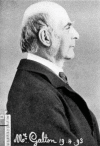Why didn't Darwin discover Mendel's laws?
- PMID: 19291260
- PMCID: PMC2687777
- DOI: 10.1186/jbiol123
Why didn't Darwin discover Mendel's laws?
Abstract
Darwin's focus on small quantitative variations as the raw material of evolution may have prevented him from discovering the laws of inheritance.
Figures







Comment in
-
The light of evolution.J Biol. 2009;8(2):10. doi: 10.1186/jbiol124. Epub 2009 Feb 27. J Biol. 2009. PMID: 19476607 Free PMC article. No abstract available.
References
-
- Mendel G. Verhandlungen des naturforschenden Vereines in Brünn. IV. Brünn: Im Verlage des Vereines; 1865. Versuche über Pflanzen-Hybriden; pp. 3–47.
-
- Darwin CR. The Origin of Species by Means of Natural Selection. London: John Murray; 1859.
-
- Darwin CR. The Effects of Cross and Self-Fertilisation in the Vegetable Kingdom. London: John Murray; 1876.
-
- Darwin CR. The Different Forms of Flowers on Plants of the Same Species. London: John Murray; 1877.
MeSH terms
LinkOut - more resources
Full Text Sources

